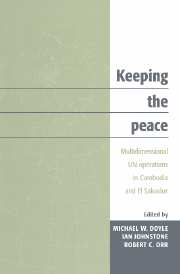Book contents
- Frontmatter
- Contents
- Preface
- Notes on the contributors
- List of abbreviations
- 1 Introduction
- Cambodia
- El Salvador
- Map
- 9 Insurrection and civil war in El Salvador
- 10 Peacemaking in El Salvador
- 11 The El Salvador Peace Accords: using international and domestic law norms to build peace
- 12 From peacekeeping to peacebuilding: restructuring military and police institutions in El Salvador
- 13 Rights and reconciliation in El Salvador
- 14 The arms-for-land deal in El Salvador
- Conclusion and chronologies
- Select bibliography
- Index
12 - From peacekeeping to peacebuilding: restructuring military and police institutions in El Salvador
Published online by Cambridge University Press: 22 October 2009
- Frontmatter
- Contents
- Preface
- Notes on the contributors
- List of abbreviations
- 1 Introduction
- Cambodia
- El Salvador
- Map
- 9 Insurrection and civil war in El Salvador
- 10 Peacemaking in El Salvador
- 11 The El Salvador Peace Accords: using international and domestic law norms to build peace
- 12 From peacekeeping to peacebuilding: restructuring military and police institutions in El Salvador
- 13 Rights and reconciliation in El Salvador
- 14 The arms-for-land deal in El Salvador
- Conclusion and chronologies
- Select bibliography
- Index
Summary
Introduction
On January 16, 1992, in a solemn ceremony in Mexico City's Castle of Chapultepec, representatives of the Salvadoran government and the Farabundo Mart National Liberation Front (FMLN) signed a comprehensive peace agreement ending twelve years of bloody civil war that left approximately 75,000 dead. So began a healing process designed to help Salvadoran society achieve an era of enduring peace. This momentous occasion also marked a transition of a different sort, as the role of the United Nations in El Salvador broadened from mediation efforts to an involvement in peacekeeping and post-conflict peacebuilding unprecedented in UN history. This chapter focuses on this second transition and the role played by UN military and police observers in post-conflict operations in El Salvador.
UN post-conflict efforts may be viewed as lying on a continuum of interdependent and sequential activities. At one end of the continuum is traditional peacekeeping – confidence-building measures such as verifying ceasefires and demobilizations, and more recently, monitoring public security forces. At the other end is peacebuilding – assistance and support for the reform or creation of national institutions and social and economic development. Somewhere in the middle, with the transition from peacekeeping to peacebuilding, the UN's focus necessarily shifts from reducing tensions and building confidence to creating conditions that facilitate lasting changes in a society.
A thicket of controversy surrounds the question of how far the UN should travel along this continuum, particularly in the direction of institutional reform.
- Type
- Chapter
- Information
- Keeping the PeaceMultidimensional UN Operations in Cambodia and El Salvador, pp. 282 - 311Publisher: Cambridge University PressPrint publication year: 1997
- 1
- Cited by

